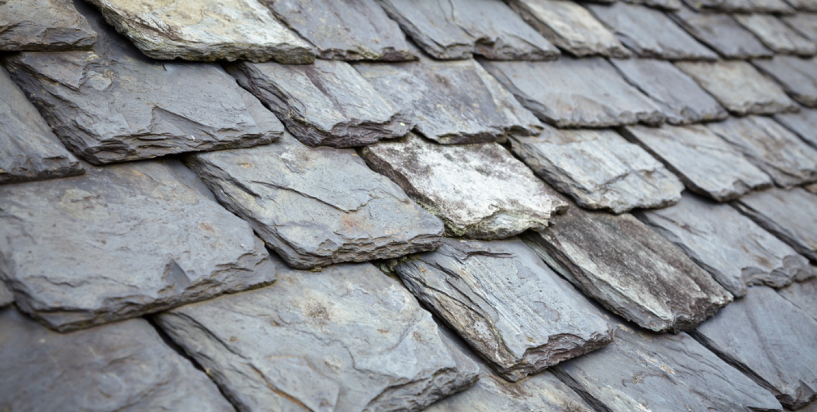Fortunately, twenty-first century roofing materials are made to withstand a wide variety of temperatures and fluctuations. Therefore, choosing a particular material over another based on the climate where you live is not as critical as it once was. If you’re in the market for a new roof, there are many materials to consider that will work well no matter where you live, including:
Slate Tile
This is the gold standard for durability in many different climates and in all kinds of weather. With a lifespan of up to one hundred years, you can expect your slate roof to stand up to multiple layers of ice and the heaviest snowfalls. Slate’s high density also makes it an outstanding insulator, capable of keeping the temperature of the interior of the home it protects stable year round. If you live in an area where lack of rain and fire risks dictate a certain type of roofing material, slate should lead your list of durable, safe options.
If there’s a downside to slate, it would be its weight. Slate shingle roofing tiles weigh between 800 and 1500 pounds per square foot. Before you decide on a slate roof and its many advantages, you will need to have a professional contractor evaluate your roof structure to be sure it is sound and strong enough to support these materials.
Metal
Over the last 20 years, the demand for metal roofing rose from a 3.7 percent share to 14 percent. This is due in part to the fact that, like slate, metal roofing materials are solid options for both colder and warmer climates, and are also likely to last a long time.
Metal roofing excels at handling extreme temperatures, especially when treated with highly reflective paint or coating. A simple re-coating can make the roofing new again despite many years of wear. In warm climates, the coated surface of a metal roof will reflect the sun, keeping the temperature of the home it protects stable. In colder climates, this same coated surface makes the metal surface smooth and slick, making ice and snow slide off quickly before it can accumulate.
Like slate, metal roofing is fire-resistant and needs minimum maintenance. It can also last three times longer when compared to a typical asphalt shingle roof. A metal roof is much lighter than one made from slate. Installed correctly, a metal roof will help your home obtain and maintain optimal temperature year round, lowering your energy bills.
Depending on a variety of variables, a metal roof will cost anywhere from $7 to $10 per square foot. While this represents a more substantial investment than an asphalt roof, the long-term energy efficiency and higher resale value you can expect with a metal roof on your home make it a sound choice.
Shingles
Traditional shingles are an affordable choice for all types of weather. Keep in mind, however, that while these roofs are effective protection against extreme weather for multiple years, they can crack and incur other weather-related damage should they encounter really harsh conditions.
If you’re looking for more longevity, wooden shakes (a certain type of shingle) can provide up to thirty years of effective service. And because they circulate air so efficiently, wooden shakes can help save you energy, too.
“Super shingles” offer four times more protection than regular shingles—which also means they deliver four times more energy-efficient benefits. Especially if they come with a lifetime warranty, super shingles are an excellent choice for roofing material no matter where you live.
Clay Shingles
Recognizable by their rich, earthy tones, clay roof shingles have more to offer than just aesthetics. Not only are they thermal-resistant and fire-retardent, clay roof shingles are eco-friendly, too. They are also well known for maintaining temperatures at both ends of the spectrum. Clay roof shingles can cost anywhere from $10 to $18 per square foot, and installation can be a bit more expensive, too.
EPDM
This is commonly called “rubber roofing”, also known as rubber membrane roofing or rolled rubber roofing. A mixture of slate dust, recycled tires, and sawdust, EPDM is relatively lightweight, easy to install, and costs significantly less than competitive roofing choices. Because they have very few seams, an EPDM roof has little chance of leaking and will last roughly 20 years.
Although the typical EPDM is black and absorbs heat, the surface is not easily damaged by UV rays—allowing them to hold up well in hot, sunny climates. It is possible to select an EPDM installation in a lighter color that will not only be more attractive within some color schemes but which will also help reflect more heat.
Because a new roof is a big investment, it makes sense to review your options with an experienced professional. Look at the pros and cons and make the decision that is right for you.














